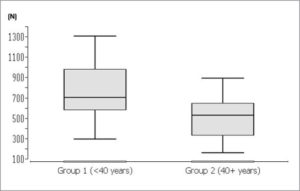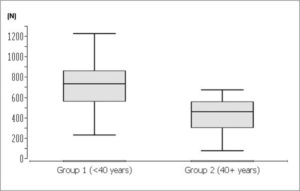It is a well-known fact that as we get old, our bodies (sadly) deteriorate, leaving us unable to perform certain physical functions as easily as we could have when we were younger. In this article, the authors describe a study done to analyze muscle loss due to aging, primarily by examining two different age groups of humans. By conducting measurements on people over and under the age of 40 years, results show a clear difference in muscle mass and strength between the two.
Karsten Keller and Martin Engelhardt conducted their study on 14 adults under the age of 40 and 12 adults over the age of 40. They measured the circumference (size) of each leg of the participants in four different locations at 10 and 20 cm above the knee, and 10cm below it along with the largest circumference position below the knee. In addition, they conducted strength tests based on the motion of the leg at 30˚ and 60˚ from resting sitting position using the Dynamometer BIODEX® System 3.
Results given in the article can be viewed in full here, but as a summary both the overall size and strength of legs was stronger in the younger participant group than in the older group. According to the authors, we as human beings generally are at our physical peak throughout the 20-30 year age range. From analyzing their own experimental results, Keller and Engelhardt conclude that our muscle mass generally begins to decline after about 40 years of age. The factors that contribute to the size and strength of our muscles declining due to aging is varied and complex, but one reason for our weakening is that as we age our muscle fibers decline in number. Once enough fibers are lost, our bodies experience apoptosis, or the destruction of cells. Anabolic hormone decrease, risk of disease, appetite loss, and declining of physical activity are all other large factors attributed to muscle loss in aging.


Human beings get old, and physically, it is not that great. Our muscle strength and size decline due to a number of factors. However, we can help ourselves fight physical aging by paying attention to our health, specifically maintaining some physical strength training and ensuring we receive nutrients to feed our muscles. The authors recognize the limitations of this study, including small sample size and desiring ages from every decade; however they are able to conclude by stating that their data shows that muscle declines after 40 years of age in a range from 16.6% – 40.9%. To learn more about some causes of muscle loss through aging, such as sarcopenia, inactivity, and physiological changes check out these articles.
Featured image by Victor Freitas on Unsplash

